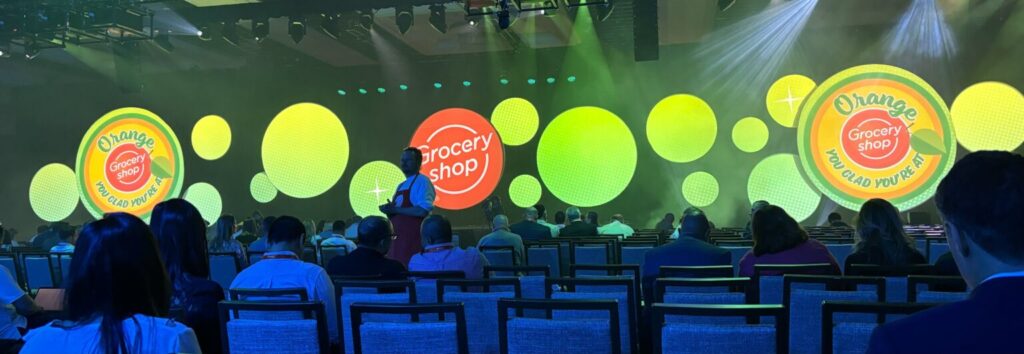This is your third year attending Groceryshop. What surprised you or was different this time around?
The first is that brands are getting more involved as attendees and speakers, highlighting what they are doing to stand out and bring value to shoppers. Between online grocery shopping and the high competition across regional, specialty and national grocery retailers, investing in shopper experience is top of mind, and brands are increasingly eager to explain how they are winning the grocery CX game.
The second is the increased focus on in-store retail media, a main reason I attended this year’s show. Groceryshop dedicated an entire stage for speakers to share the latest research and strategies. The industry is working hard to standardize measurement for in-store retail media, and implementing an advanced sensor technology solution, like Walkbase, is a critical first step.
You participated in Meetup. Can you describe that experience? Is it difficult to convey the value of in-store technology and media networks in a short amount of time?
The Meetups are always the highlight of my show. The opportunity to sit down with so many retailers and brands in a short amount of time is so valuable. The meetings are much more than just a chance to deliver a product pitch — they provide a chance to make an introduction, receive feedback and really understand the challenges technology companies like Walkbase can help retailers solve. The fundamental value of in-store technology and monetizing media networks is there, so we are able to dive into details about their own goals and challenges. It’s a fast but highly valuable conversation.
What were some of the main challenges that kept coming up in your discussions with retailers?
For in-store retail media, the consumer experience and capital expenses were top concerns. Neither are easy challenges to solve, but fortunately the brands in the STRATACACHE family — including Walkbase, PRN and Scala — have years of experience in the space, creating, monetizing, measuring and supporting in-store networks.
Another challenge is building a strategy around the entire customer journey, which is key. Digital marketers know how their customers behave online and have for some time. What’s needed is the same granular view of how shoppers behave in-store, which Walkbase can provide in a privacy-friendly manner.
As for the capital expense piece, working with a partner that understands and is transparent about the economics of in-store can help. We often take a “crawl, walk, run approach,” recommending you start with a few stores to see the power of the data and scale up from there. Let us put in some sensors, start collecting data, and right away you’ll see the value of adding a data layer of knowledge to your in-store experience.
In-store retail media continues to be a hot topic at events like Groceryshop. Where did your conversations around it lead?
Many of my discussions focused on how retailers can show brands the impact in-store retail media has on incremental sales — how they can tie a transaction to an impression and show conversion. With the right measurement infrastructure in place, retailers can easily prove the value of their networks and uncover new revenue streams along the way.
Were there specific Walkbase solutions or capabilities that resonated with attendees?
People I spoke to were very excited about our capabilities to prove ROI for in-store retail media networks. By attaching sensors near retail media screens, we can link ad impressions to video plays and provide closed-loop attribution when that behavioral data is connected to loyalty and transaction data at checkout.
Store innovation and operations attendees were interested in our ability to collect other in-store behavioral data, such as pathing and dwell time data, using overhead sensors and asset tags on shopping carts and baskets. That information can help them enhance labor efficiencies, improve merchandising decisions and test new store layouts. They appreciated the fact that the data isn’t just dumped on their teams, but presented in easily digestible, real-time dashboards that include things such as heatmaps.
Were you able to attend any sessions in between meetings? Which one or ones did you find the most valuable?
Yes, I was able to attend a few sessions over the three days. I was fortunate to hear about the latest initiatives from Kroger, Sam’s Club and Giant Eagle and sit in on a very valuable session on the opportunity in-store retail media presents. One slide really stood out to me featuring this eMarketer stat: In-store retail media spend will top $1 billion by 2028. This shows that brands want to invest and are either increasing or shifting their budgets away from other traditional channels.
What were your top takeaways from attending the conference?
First, consumers value their time a lot. As technology providers, we need to continue to figure out how to help retailers speed up the customer journey, or make it more efficient, without jeopardizing price, experience or order accuracy.
Second, brands are ready to invest in in-store retail media but need to see meaningful results and accurate data around their campaigns. Understanding measurement is key here.
Third, finding ways to improve employee efficiency remains a top priority. It starts with giving associates access to the right data, which leads to better decisions.
Lastly, providing value really matters to retailers. They continue to challenge brands to innovate and focus on improving their own loyalty programs. Helping them grow those programs should be top of mind for us as partners.
As someone who attends multiple trade shows each year, what themes and trends do you see keep resurfacing?
Every trade show I attend has a bit of a different focus, but it’s great to see the continued interest in leveraging the physical store as a media channel. Other themes that keep coming up include data and privacy, digital engagement by consumers and the concept of unified commerce — connecting the online and in-store shopping journeys.
